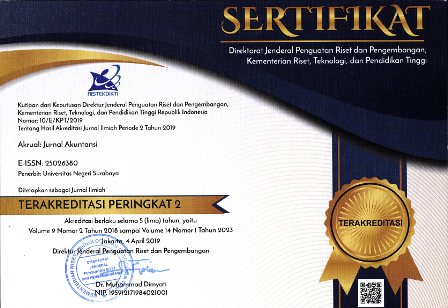Profitabilitas, Investasi Dan Arus Kas Sebagai Prediktor Tingkat Pengembalian Saham
DOI:
https://doi.org/10.26740/jaj.v3n2.p130-146Keywords:
Profitability, Investment, Cashflow, Accrual value, Stock returnAbstract
Abstract
This research aim to calculate influence from some financial performance (B/M ratio, market capitalization, earning position, investment, accrual value, company strength measurement, dividend policy, and profitability) to stock return. Multiregression model follow Fama and French procedure. Result of first hypothesis confirmed statistically, that the difference of stock of return pursuant to finance performance not automatically own significant influence in stock return prediction itself. Other result confirmed that all the predictor used has no significant influence to stock return both simultaneously and partial.
Keyword: Profitability, Investment, Cashflow, Accrual value, Stock return
References
Abarbanell, Jeffrey S., and Victor L. Bernard, 1992, Tests of analysts overreaction/underreaction to earnings information as an explanation for anomalous stock price behavior, Journal of Finance 47, 1181-1207. https://doi.org/10.1111/j.1540-6261.1992.tb04010.x
Abarbanell, Jeffrey S., and Brian J. Bushee, 1998, Abnormal returns to a fundamental analysis strategy, The Accounting Review 73, 19-45. https://doi.org/10.2139/ssrn.40740
Ahmed, Anwer S., S. M. Khalid Nainar, and X. Frank Zhang, 2003, Further evidence on analyst and investor mis-weighting of prior period cash flows and accruals, working paper, University of Chicago.
Ali, Ashiq, April Klein, and James Rosenfeld, 1992, Analysts use of information about permanent and transitory earnings components in forecasting annual EPS, The Accounting Review 67, 183-198.
Campbell, John, and Robert J. Shiller, 1988, The dividend-price ratio and expectations for future dividends and discount factors, Review of Financial Studies 1, 195-228. https://doi.org/10.1093/rfs/1.3.195
Capaul, Carlo, Ian Rowley, and William F. Sharpe, 1993, International value and growth stock returns, Financial Analysts Journal, January-February, 27-36. https://doi.org/10.2469/faj.v49.n1.27
Chan, Konan, Louis K. C. Chan, Narasimhan Jegadeesh, and Josef Lakonishok, 2006, Earnings quality and stock returns, Journal of Business 79. https://doi.org/10.3386/w8308
Chan, Louis K.C., Yasushi Hamao, and Josef Lakonishok, 1991, Fundamentals and stock returns in Japan, Journal of Finance 46, 1739-1789. https://doi.org/10.2307/2328571
Cohen, Randolph B., Paul A. Gompers, and Tuomo Vuolteenaho, 2002, Who underreacts to cash-flow news? Evidence from trading between individuals and institutions, Journal of Financial Economics, 66, 409-462. https://doi.org/10.3386/w8793
Collins, Daniel W., and Paul Hribar, 2000, Earnings-based and accrual-based market anomalies: one effect or two?, Journal of Accounting and Economics 29, 101-123. https://doi.org/10.1016/s0165-4101(00)00015-x
Dechow, Patricia M., Amy P. Hutton, and Richard G. Sloan, 2000, An empirical assessment of the residual income valuation model, Journal of Accounting and Economics, 26, 1-34. https://doi.org/10.1016/s0165-4101(98)00049-4
Easterwood, John C., and Stacy R. Nutt, 1999, Inefficiency in analysts earnings forecasts: Systematic misreaction or systematic optimism?, Journal of Finance 54, 1777-1797. https://doi.org/10.1111/0022-1082.00166
Fairfield, Patricia M., Scott Whisenant, and Terry Lombardi Yohn, 2002, The differential persistence of accruals and cashflows for future operating income versus future return on assets, working paper, Georgetown University.
Fairfield, Patricia M., Scott Whisenant, and Terry Lombardi Yohn, 2003, Accrued earnings and growth: Implications for future profitability and market mispricing, The Accounting Review 78, 353-371. https://doi.org/10.2308/accr.2003.78.1.353
Fama, Eugene F., and Kenneth R. French, 1992, The cross-section of expected stock returns, Journal of Finance 47, 427-465. https://doi.org/10.2307/2329112
Fama, Eugene F., and Kenneth R. French, 1993, Common risk factors in the returns on stocks and bonds, Journal of Financial Economics 33, 3-56. https://doi.org/10.1016/0304-405x(93)90023-5
Fama, Eugene F., and Kenneth R. French, 1995, Size and book-to-market factors in earnings and returns, Journal of Finance 50, 131-155. https://doi.org/10.1111/j.1540-6261.1995.tb05169.x
Fama, Eugene F., and Kenneth R. French, 2001, Disappearing dividends: Changing firm characteristics or lower propensity to pay, Journal of Financial Economics, 60, 3-43. https://doi.org/10.1016/s0304-405x(01)00038-1
Fama, Eugene F., and James MacBeth, 1973, Risk, return, and equilibrium: Empirical tests, Journal of Political Economy 81, 607-636. https://doi.org/10.1086 /260061
Frankel, Richard, and Charles M. C. Lee, 1998, Accounting valuation, market expectation, and crosssectional stock returns, Journal of Accounting and Economics, 25, 283-319. https://doi.org/10.1016/s0165-4101(98)00026-3
Griffin, John M., and Michael L. Lemmon, 2002, Does book-to-market equity proxy for distress risk or mispricing?, Journal of Finance, 57, 2317-2336. https://doi.org/10.1111/1540-6261.00497
Haugen, Robert A., and Nardin L. Baker, 1996, Commonality in the determinants of expected stock returns, Journal of Financial Economics, 41, 401-439. https://doi.org/10.1016/0304-405x(95)00868-f
Lakonishok, Josef, Andrei Shleifer, and Robert W. Vishny, 1994, Contrarian investment, extrapolation, and risk, Journal of Finance 49, 1541-1578. https://doi.org/10.1111/j.1540-6261.1994.tb04772.x
Lee, Charles, David Ng, Bhaskaran Swaminathan, 2004, International Asset Pricing: Evidence from the Cross Section of Implied Cost of Capital, working paper, Cornell University.
Mitchell, Mark L, and Erik Stafford, 2000, Managerial decisions and long-term stock price performance, Journal of Business 73, 287-329. https://doi.org/10.1086/209645
Ohlson, James A., 1980, Financial ratios and the probabilistic prediction of bankruptcy, Journal of Accounting Research, 18, 109-131. https://doi.org/10.2307/2490395
Penman, Stephen H., 1991, An evaluation of accounting rate of return, Journal of Accounting, Auditing, and Finance 6, 233-255. https://doi.org/10.1177/0148558x9100600204
Piotroski, Joseph D., 2000, Value investing: The use of historical financial statement information to separate winners from losers, Journal of Accounting Research, 38 (Supplement), 1-42. https://doi.org/10.2307/2672906
Richardson, Scott A., Richard G. Sloan, 2003, External financing and future stock returns, working paper, University of Pennsylvania.
Richardson, Scott A., Richard G. Sloan, Mark T. Soliman, and Irem Tuna, 2004, The implications of accounting distortions and growth for accruals and profitability, working paper, University of Pennsylvania.
Richardson, Scott A., Richard G. Sloan, Mark T. Soliman, and Irem Tuna, 2005, Accrual reliability, earnings persistence, and stock prices, Journal of Accounting and Economics 39. https://doi.org/10.1016/j.jacceco.2005.04.005
Rosenberg, Barr, Kenneth Reid, and Ronald Lanstein, 1985, Persuasive evidence of market inefficiency, Journal of Portfolio Management 11, 9-17 https://doi.org/10.3905/jpm.1985.409007
Sloan, Richard G., 1996, Do stock prices fully reflect information in accruals and cash flows about future earnings?, The Accounting Review 71, 289-315.
Titman, Sheridan, K.C. John Wei,and Feixue Xie, 2005, Capital investments and stock returns, Journal of Financial and Quantitative Aanalysis 39, 677-700. https://doi.org/10.3386/w9951
Xie, Hong, 2001, The mispricing of abnormal accruals, The Accounting Review 76, 357-373. https://doi.org/10.2308/accr.2001.76.3.357
Downloads
Published
How to Cite
Issue
Section
 Abstract views: 851
,
Abstract views: 851
, PDF Downloads: 395
PDF Downloads: 395


















